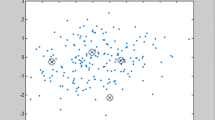Abstract
In this paper, a feature-level fusion based approach is proposed for blind image steganalysis. We choose three types of typical higher-order statistics as the candidate features for fusion and make use of the Boosting Feature Selection (BFS) algorithm as the fusion tool to select a subset of these candidate features as the new fusion feature vector for blind image steganalysis. Support vector machines are then used as the classifier. Experimental results show that the fusion based approach increases the blind detection accuracy and also provides a good generality by identifying an untrained stego-algorithm. Moreover, we evaluate the performance of our candidate features for fusion by making some analysis of the components of the fusion feature vector in our experiments.
Preview
Unable to display preview. Download preview PDF.
Similar content being viewed by others
References
Johnson, N.F., Jajodia, S.: Exploring steganography: Seeing the unseen. In: Computer, vol. 31, pp. 26–34. IEEE Computer Society, Los Alamitos (1998)
Provos, N.: Defending against statistical steganalysis. In: Proceedings of the 10th USENIX Security Symposium, pp. 323–336 (2001)
Fridrich, J., Goljan, M.: Practical steganalysis of digital images — state of the art. In: Security and Watermarking of Multimedia Contents, vol. SPIE-4675, pp. 1–13 (2002)
Tzschoppe, R., Aauml, R.B.: Steganographic system based on higher-order statistics. In: Proceedings of SPIE,Security and Watermarking of Multimedia Contents V,USA, vol. 5020 (2003)
Farid, H.: Detecting hidden messages using higher-order statistics and support vector machines. In: 5th International Workshop on Information Hiding (2002)
Harmsen, J.J., Pearlman, W.A.: Steganalysis of additive noise modelable information hiding. In: Proc. SPIE, Security, Steganography, and Watermarking of Multimedia Contents VI, pp. 131–142 (2003)
Goljan, M., Fridrich, J., Holotyak, T.: New blind steganalysis and its implications. In: Proc. SPIE, Security, Steganography, and Watermarking of Multimedia Contents VI, pp. 1–13 (2006)
Friedma, F., Hastie, T.: Additive logistic regression: a statistical view of boosting (1998)
Tieu, K., Viola, P.: Boosting image retrieval. In: IEEE Conf.on Computer Vision and Pattern Recognition, pp. 228–235 (2002)
Jain, A.K.: Score normalization in multimodal biometric systems. Pattern Recognition 38, 2270–2285 (2005)
Kharrazi, M.: Improving steganalysis by fusion techniques: A case study with image steganography. In: Tran. On Data Hiding and Multimedia Security, pp. 123–137 (2006)
Xuan, G., Shi, Y.Q.: Steganalysis based on multiple features formed by statistical moments of wavelet characteristics functions. In: Proc. Information Hiding Workshop, pp. 262–277 (2005)
Shi, Y.Q., et al.: Image steganalysis based on moments of characteristic functions using wavelet decomposition, prediction-error image,andneural network. In: ICME 2005, pp. 269–272 (2005)
Sullivan, K., et al.: Steganalysis for markov cover data with applications to images. IEEE Trans.Inf. Forensics Security 1, 275–287 (2006)
Chen, X.C., Wang, Y.H., Guo, L., Tan, T.N.: Blind image steganalysis based on statistical analysis of empirical matrix. In: ICPR (3) 2006, pp. 1107–1110 (2006)
Joachims, T.: Making large-scale svm learning practical,in adavances in kernel methods-support vector learning. In: Scholkopf, B., Burges, C. (eds.). MIT Press, Cambridge (1999)
Cox, I.J., Kilian, J., Leighton, F.T., Shamoon, T.: Secure spread spectru, watermarking for multimedia. IEEE Trans.Image Process 6(12), 1673–1687 (1997)
Huang, J., Shi, Y.Q.: Adaptive image watermarking scheme based on visual masking. Electron, Letter 34, 748–750 (1998)
Lie, W.N., Chang, L.C.: Data hiding in images with adaptive numbers of least significant bits based on human visual system. In: Proc. IEEE Int. Conf. Image Processing, pp. 286–290 (1999)
Chen, B., Wornell, G.W.: Digital watermarking and information embedding using dither modulation. In: Proceedings of IEEE MMSP, pp. 273–278 (1998)
Piva, A., Barni, M., Bartolini, E., Cappellini, V.: Dct-based watermark recovering without resorting to the uncorrupted original image. In: Proc. ICIP 1997, vol. 1, p. 520 (1998)
Author information
Authors and Affiliations
Editor information
Editors and Affiliations
Rights and permissions
Copyright information
© 2008 Springer-Verlag Berlin Heidelberg
About this paper
Cite this paper
Dong, J., Chen, X., Guo, L., Tan, T. (2008). Fusion Based Blind Image Steganalysis by Boosting Feature Selection. In: Shi, Y.Q., Kim, HJ., Katzenbeisser, S. (eds) Digital Watermarking. IWDW 2007. Lecture Notes in Computer Science, vol 5041. Springer, Berlin, Heidelberg. https://doi.org/10.1007/978-3-540-92238-4_8
Download citation
DOI: https://doi.org/10.1007/978-3-540-92238-4_8
Publisher Name: Springer, Berlin, Heidelberg
Print ISBN: 978-3-540-92237-7
Online ISBN: 978-3-540-92238-4
eBook Packages: Computer ScienceComputer Science (R0)




